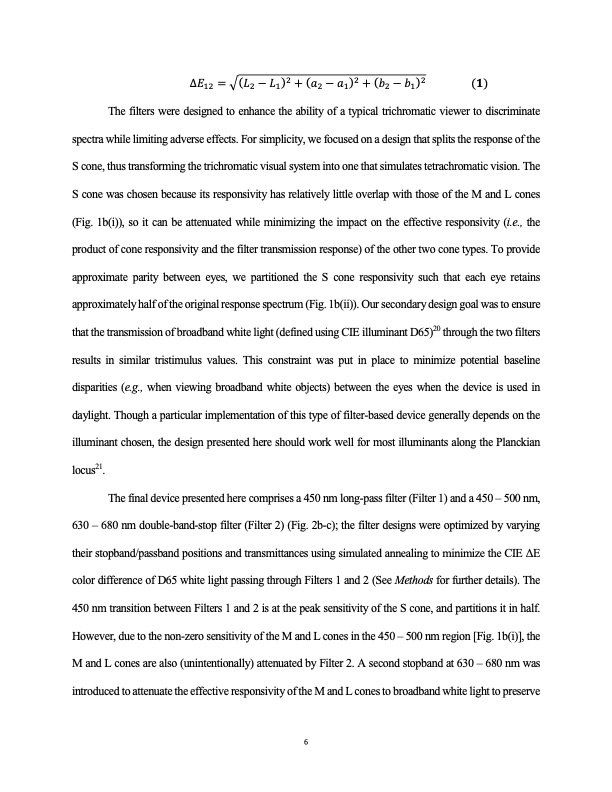
PDF Publication Title:
Text from PDF Page: 006
∆𝐸12 =√(𝐿2 −𝐿1)2 +(𝑎2 −𝑎1)2 +(𝑏2 −𝑏1)2 (𝟏) The filters were designed to enhance the ability of a typical trichromatic viewer to discriminate spectra while limiting adverse effects. For simplicity, we focused on a design that splits the response of the S cone, thus transforming the trichromatic visual system into one that simulates tetrachromatic vision. The S cone was chosen because its responsivity has relatively little overlap with those of the M and L cones (Fig. 1b(i)), so it can be attenuated while minimizing the impact on the effective responsivity (i.e., the product of cone responsivity and the filter transmission response) of the other two cone types. To provide approximate parity between eyes, we partitioned the S cone responsivity such that each eye retains approximately half of the original response spectrum (Fig. 1b(ii)). Our secondary design goal was to ensure 20 that the transmission of broadband white light (defined using CIE illuminant D65) through the two filters results in similar tristimulus values. This constraint was put in place to minimize potential baseline disparities (e.g., when viewing broadband white objects) between the eyes when the device is used in daylight. Though a particular implementation of this type of filter-based device generally depends on the illuminant chosen, the design presented here should work well for most illuminants along the Planckian locus21. The final device presented here comprises a 450 nm long-pass filter (Filter 1) and a 450 – 500 nm, 630 – 680 nm double-band-stop filter (Filter 2) (Fig. 2b-c); the filter designs were optimized by varying their stopband/passband positions and transmittances using simulated annealing to minimize the CIE ΔE color difference of D65 white light passing through Filters 1 and 2 (See Methods for further details). The 450 nm transition between Filters 1 and 2 is at the peak sensitivity of the S cone, and partitions it in half. However, due to the non-zero sensitivity of the M and L cones in the 450 – 500 nm region [Fig. 1b(i)], the M and L cones are also (unintentionally) attenuated by Filter 2. A second stopband at 630 – 680 nm was introduced to attenuate the effective responsivity of the M and L cones to broadband white light to preserve 6PDF Image | Enhancing color vision by breaking binocular redundancy

PDF Search Title:
Enhancing color vision by breaking binocular redundancyOriginal File Name Searched:
enhancing-human-color-vision-670-nm.pdfDIY PDF Search: Google It | Yahoo | Bing
Cruise Ship Reviews | Luxury Resort | Jet | Yacht | and Travel Tech More Info
Cruising Review Topics and Articles More Info
Software based on Filemaker for the travel industry More Info
The Burgenstock Resort: Reviews on CruisingReview website... More Info
Resort Reviews: World Class resorts... More Info
The Riffelalp Resort: Reviews on CruisingReview website... More Info
| CONTACT TEL: 608-238-6001 Email: greg@cruisingreview.com | RSS | AMP |